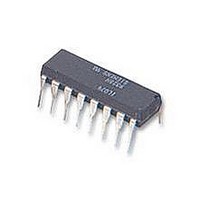PCF8591P NXP Semiconductors, PCF8591P Datasheet - Page 14

PCF8591P
Manufacturer Part Number
PCF8591P
Description
IC, A/D AND D/A CONVERTER, 8BIT, 16-DIP
Manufacturer
NXP Semiconductors
Type
General Purposer
Specifications of PCF8591P
Number Of Channels
1
Number Of Adc's
1
Number Of Dac's
1
Adc/dac Resolution
8b
Interface Type
Serial (I2C)
Operating Supply Voltage (typ)
3.3/5V
Sample Rate
11.1KSPS
Number Of Adc Inputs
4
Number Of Dac Outputs
1
Operating Supply Voltage (max)
6V
Operating Supply Voltage (min)
2.5V
Operating Temperature (max)
85C
Operating Temperature (min)
-40C
Pin Count
16
Mounting
Through Hole
Supply Voltage Range
2.5V To 6V
Operating Temperature Range
-40°C To +85°C
Digital Ic Case Style
DIP
No. Of Pins
16
Linearity Error -
1.5LSB
Termination Type
DIP
Supply Voltage Max
8V
Input Channels Per Adc
1
Rohs Compliant
Yes
Filter Terminals
DIP
Conversion Time
90µs
Data Interface
I2C, Serial
Lead Free Status / RoHS Status
Compliant
Available stocks
Company
Part Number
Manufacturer
Quantity
Price
Company:
Part Number:
PCF8591P
Manufacturer:
SANYO
Quantity:
20 200
Company:
Part Number:
PCF8591P
Manufacturer:
NXP
Quantity:
5 510
Philips Semiconductors
8.3
A device generating a message is a ‘transmitter’, a device receiving a message is the ‘receiver’. The device that controls
the message is the ‘master’ and the devices which are controlled by the master are the ‘slaves’.
8.4
The number of data bytes transferred between the start and stop conditions from transmitter to receiver is not limited.
Each data byte of eight bits is followed by one acknowledge bit. The acknowledge bit is a HIGH level put on the bus by
the transmitter whereas the master also generates an extra acknowledge related clock pulse. A slave receiver which is
addressed must generate an acknowledge after the reception of each byte. Also a master must generate an
acknowledge after the reception of each byte that has been clocked out of the slave transmitter. The device that
acknowledges has to pull down the SDA line during the acknowledge clock pulse, so that the SDA line is stable LOW
during the HIGH period of the acknowledge related clock pulse. A master receiver must signal an end of data to the
transmitter by not generating an acknowledge on the last byte that has been clocked out of the slave. In this event the
transmitter must leave the data line HIGH to enable the master to generate a stop condition.
1998 Jul 02
8-bit A/D and D/A converter
handbook, full pagewidth
System configuration
Acknowledge
SDA
SCL
TRANSMITTER /
RECEIVER
MASTER
BY TRANSMITTER
DATA OUTPUT
DATA OUTPUT
BY RECEIVER
SCL FROM
MASTER
RECEIVER
condition
Fig.14 Acknowledgement on the I
START
SLAVE
S
Fig.13 System configuration.
1
TRANSMITTER /
RECEIVER
14
SLAVE
2
2
C-bus.
TRANSMITTER
MASTER
not acknowledge
acknowledge
8
acknowledgement
clock pulse for
TRANSMITTER /
RECEIVER
MASTER
9
Product specification
MBC602
PCF8591
MBA605
















